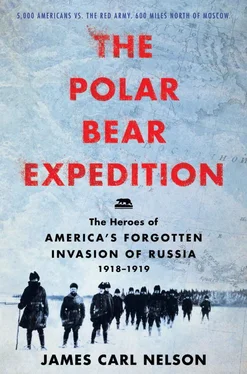Undeterred, Force B advanced and at five P.M. attacked. By ten thirty that evening, the town was clear of Bolsheviks, except for a few prisoners. During the fight, one British officer and five soldiers—one Polish and four French—were killed; one of the Olympia ’s sailors, George Dewey Perschke, was shot in the arm and became the first casualty the Americans would suffer in the campaign. Many would follow.
Force B then returned to Tiogra for a week’s rest. On August 22, new orders fell from the sky—literally. A British plane zoomed over the force and dropped orders for the men to abandon, for now, their move on Plesetskaya and instead turn and attack Obozerskaya from the east, while Force A would assault it from the north.
Before most of Force B left for Obozerskaya on August 27, it was reinforced by fifty-three anti-Red Russians and two machine guns. The Russians were sent south to Seletskoe to guard the flank of the main force, which advanced nineteen miles toward Obozerskaya the first day and another thirteen on August 28. That same day, Force B learned from scouts that a large group of Red sailors was once more headed toward Seletskoe.
An American sailor, Corbin Hardaway, was dispatched on a horse to alert headquarters at Tiogra of the pending attack, and he earned a Navy Cross for “accomplishing a long march successfully under trying conditions, and at times practically within the enemy’s lines,” as his citation reads.
Hicks and Force B began encountering Bolsheviks as they approached Obozerskaya from the east; the Americans cut their way through the opposition, and were in line and ready to attack as planned at six A.M. on August 31. Rushing the Bolsheviks, they were forced to ground “due to heavy resistance met,” as Hicks would later report.
The fighting was intense through the day, and on the night of August 31 Hicks and his sailors took over the front line from the French. Two more seamen were wounded that day, one taking a bullet in the arm and the other spraining his ankle.
The next day, the fighting continued, but before noon it was learned that the Reds behind them had taken Seletskoe—the supposedly anti-Bolshevik Russians there, it was reported, had “fired three shots” and then fled—and were now moving west toward Obozerskaya.
Encountering heavy opposition before Obozerskaya, and now also facing annihilation from the rear, Force B retraced its steps thirteen miles and set up defenses across the road from Tiogra to Obozerskaya. The next day, a small force of French soldiers was sent almost a mile east and ordered to hold at least until five P.M., while the main body of Force B set off across swamps and woods for the railway at Obozerskaya.
Hicks and his sailors, meanwhile, were ordered to hold the original line and then relieve the poilus (French soldiers) that night—but at two thirty in the afternoon, the French came back to the main line, where they and the sailors beat back a Bolshevik bayonet charge. The French then took off west, following the rest of Force B.
Ordered to reinforce Hicks and the other seamen at the main defense line that night, the Russians instead plundered the force’s supply wagons. Hicks decided to get while the getting was good, and destroyed as much of the remaining supplies and equipment as he could before he and his merry band also took off west, moving cross-country.
Force B was now as good as lost, out of touch with the Allied command as its men waded through swamps and trekked night and day across the heavily forested Russian north, their empty stomachs gnawing at them and their legs giving way from the effort. Finally, on September 5, the main body of Force B emerged at the railway above Obozerskaya, followed by Hicks and the Olympia sailors, who emerged from the woods thirteen miles to the north.
There, they received rations from the French and were ordered to escort a trainload of 123 Bolshevik prisoners to Isakagorka, just south of Archangel, to which the sailors finally returned on September 6 after their arduous adventure.
By then, though, they and the rest of Force B were the object of much concern among the Allied command—and their meanderings and disappearance would directly affect the fates of the men of the 339th Infantry Regiment, which was still plowing across the White Sea as the first Americans went into action in the gloomy forests of Russia.
Chapter Four
We’re Here Because We’re Here
The trains swayed and jerked and rattled as they knifed deeper, ever deeper, into the heart of northern Russia in the second week of September 1918. All through the night they rolled, while in boxcars the men fitfully tried to sleep, or gave up and sat in the doorways, their legs dangling limply, their minds wandering but always coming back to the strangeness of their predicament, this, their great adventure.
At one point the trains stopped at a remote railway outpost, and those awake saw by torchlights a herd of prisoners taken in the previous days of fighting at Obozerskaya. To the Americans they seemed unsoldierly, an “unheroic spectacle,” one soldier would write. “They look like Bolo wild men,” one American joked; from that time on, the Bolsheviks would be referred to as just that—Bolos.
The trains, and men, moved on. Somewhere ahead, they had been told, American sailors were fighting for their lives, and so here they were, these men of the Third Battalion, 339th Infantry Regiment, coming to save American lives and thence, according to the possibly psychotic fantasies of their British commanders, roll ever deeper and fight their way to Vologda—nearly three hundred miles—if need be, and then locate the Czechs who were said to be wandering in the wastes of Russia like a lost tribe, and so save Russia, and maybe the world itself.
Their ships—the Somali and Nagoya and Tydeus —had still been steaming for Murmansk when the urgent calls came over the wireless and told their captains to break off and head southeast toward Archangel. And so the ships turned, and in early September 1918 reached the mouth of the Dvina River, and, pulled by tugs, coursed as quickly as they could the twenty-five miles to the city.
“The entire vista was dreary and desolate,” Godfrey Anderson would recall, “the sky being heavily overcast and the vast swamps stretching interminably, unrelieved by any woodland, except for a few stunted pine trees.”
On September 4 the wharves and log homes and the blue-painted domes on the city’s great cathedral came into view. “There were several handsome churches in sight, especially one majestic cathedral with half a dozen bulbous spires that was the most imposing focal point in the entire panorama,” Anderson wrote.
The port of Archangel, into which Allied materiel had been flowing to support the czar’s great army since 1914, had been reached in 1553 by the English explorer Sir Richard Chancellor, who with three ships under his command was trying to find a northeast passage to India. When the czar, Ivan the Terrible, learned of Chancellor’s arrival on the coast, he sent orders for Chancellor to travel overland to Moscow, more than six hundred miles due south, where a trading relationship between Russia and England was soon formed.
The city of Archangel was founded thirty years later, and over the following centuries became the capital of the large Archangel District, a cosmopolitan center peopled not only by Russians of all stripes and ethnicities but seafaring Scandinavians, British, and Germans. Through the port went lumber, furs, flax, and other commodities.
In the seventeenth century prisoners were set to work on improving the town, and a large trading hall and a bazaar were constructed. As well, the Troitski Cathedral, with five domes, was constructed and featured a fourteen-foot-high wooden cross carved by Peter the Great himself. The great cathedral dominated the otherwise flat skyline of Archangel, which consisted mainly of well-fenced homes hewn from the vast forests of the region and stone buildings housing businesses.
Читать дальше








